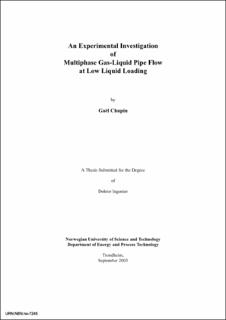| dc.description.abstract | In this thesis, the co-current flow of gas, oil and water in pipes has been studied at low input liquid loading. Despite the frequent occurrence of low liquid loaded gas flow in pipes involved in the production of gas fields, the basic flow mechanisms are not accurately accounted for by current multiphase flow models. This is partly due to a lack of experimental data, especially in three-phase gas-liquid-liquid flow.
In this thesis, new laboratory pipe flow measurements at low liquid loading have been performed in an atmospheric multiphase flow loop with air, water and oil. The initial motivation for the experiments was to test the influence of pipe material on wall wetting. Two types of experiments have been carried out: steady-state flow tests in near horizontal pipes of different material (acrylic, steel and epoxy coated steel) and transient flow tests in horizontal and vertical gas pipes of gradually changing liquid wetting. In both cases, accurate measurements of the pressure drop and phase fractions have been performed.
The wall material was found to influence the steady-state pressure drop and phase fractions in three-phase flow. Hydrophillic walls delayed the formation of dispersions in the liquid phase but also affected the distribution of droplets on the upper-pipe wall in atomization flow. It has been possible to alter the water affinity of the acrylic pipe wall by either contaminating or cleaning the wall surface, resulting in fairly different flow measurements. In vertical pipes, the presence of a thin liquid film at the wall did not result in drag reduction as was expected theoretically. Despite the low liquid holdup at the wall, the frictional pressure drop was significantly higher than for single phase gas flow. For very thin films, the friction factor approached that of a rough pipe with an hydraulic roughness scaling with the average equivalent film thickness.
Predictions from one-dimensional multiphase pipe flow models have been compared with the experimental measurements at low liquid loading and severe discrepancies were observed. For steady gas-liquid flow in slightly inclined pipes, the Modified Apparent Rough Surface model by Grolman (1994) compared best with the experimental data. For both gas-liquid and gas-oil-water flow, the commercial simulator PETRA was relatively close to the measured data. However, when local separation of oil and water occurred in the pipe, the holdup was under predicted. For atomization flow and upper pipe wall wetting, the pressure drop was also under predicted by PETRA.
A steady-state three-phase stratified flow model has been derived in this thesis to incorporate the prediction of interfacial curvature depending on the preferred wetting of the pipe wall by either one of the liquid phases. The model gave predictions in closer agreement with measurements than three-layer models assuming flat interfaces. | en_US |
